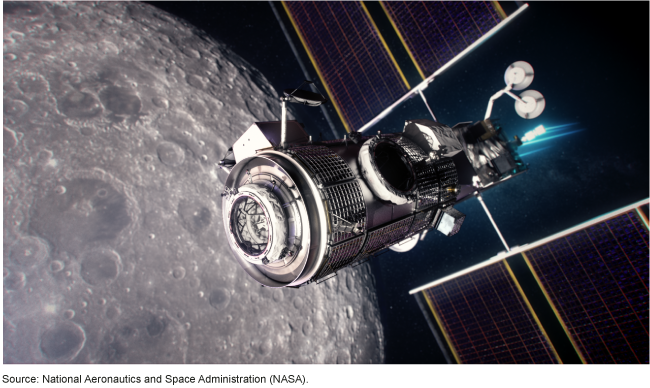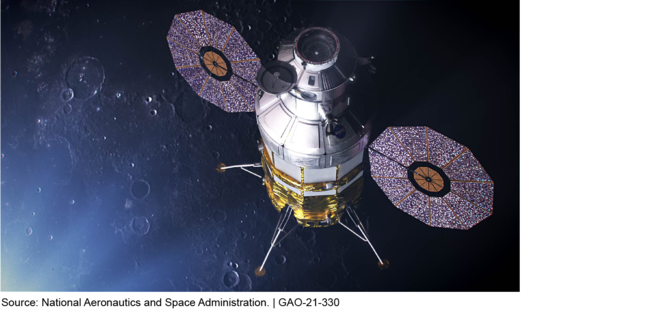NASA Lunar Programs: Significant Work Remains, Underscoring Challenges to Achieving Moon Landing in 2024
Fast Facts
Since we last reported on NASA's plans to return humans to the moon by 2024, NASA has made some progress.
But a fast-tracked schedule to meet this ambitious date—along with some technical risks—mean that it's less likely a lunar landing will happen in 2024. For example, most of the lunar projects are still early in development and some are relying on immature technology.
In addition, a 2020 NASA study recommended changes to the management structure for the lunar programs. We made 4 recommendations to NASA in this report, including to take further action in response to that study.
Artist Rendering of the First Two Components of the Gateway Outpost, Targeted to Launch Together in 2024

Highlights
What GAO Found
The National Aeronautics and Space Administration (NASA) has initiated eight lunar programs since 2017 to help NASA achieve its goal of returning humans to the Moon. NASA plans to conduct this mission, known as Artemis III, in 2024. NASA has made progress by completing some early lunar program development activities including initial contract awards, but an ambitious schedule decreases the likelihood of NASA achieving its goal. For example, NASA's planned pace to develop a Human Landing System, shown below, is months faster than other spaceflight programs, and a lander is inherently more complex because it supports human spaceflight.
Notional Human Landing System

NASA also faces technical risks. For example, the Gateway—which NASA is developing to be an outpost orbiting the Moon—will rely on power and propulsion technology that has never before been used, and contractor efforts to develop the technology are behind schedule. NASA officials said they do not have a technology backup that would meet mission requirements. GAO best practices for technology assessments state that if a technology is not adequately mature, management should assess off-ramps at milestones. For this program, off-ramps would include potentially reducing the amount of power the system is required to provide to the Gateway or reassessing the schedule to allow for more time to develop the technology. NASA risks costly design changes or delays if the agency does not identify off-ramps before committing significant resources.
NASA has not fully addressed management challenges related to its lunar programs that were identified in a 2020 NASA-sponsored study. For example, GAO found that NASA assigned Artemis mission roles and responsibilities to specific divisions in response to a study finding; however, the agency has not clearly documented how it determined what key programmatic and technical tools it plans to use to guide mission decision-making. Without doing so, NASA cannot ensure that it has the appropriate processes in place to track how the missions will achieve objectives and address risks at the mission level.
Why GAO Did This Study
In March 2019, the White House directed NASA to accelerate its plans for a lunar landing by 4 years, to 2024. Accomplishing this goal will require extensive coordination across lunar programs and contractors to ensure systems operate together seamlessly and safely. In December 2019, GAO found that NASA had begun making decisions related to requirements, cost, and schedule for individual lunar programs but was behind in taking these steps for the Artemis III mission.
The House Committee on Appropriations included a provision in 2018 for GAO to review NASA's proposed lunar-focused programs. This is the second such report. This report assesses the extent to which NASA has (1) made progress on its lunar programs, including for the 2024 lunar landing goal, and (2) addressed challenges related to its management of lunar programs.
GAO analyzed lunar mission and program documents and assessed the results of a 2020 NASA-sponsored study on lunar program status. GAO interviewed NASA officials on lunar program progress and risks and on plans to address study findings.
Recommendations
GAO is making four recommendations, including that NASA assess off-ramps for an immature Gateway technology and document the process for determining key programmatic and technical tools for the Artemis missions. NASA concurred with three of the recommendations, but did not concur with the fourth, which related to the costs included in a lunar rover's cost estimate. GAO believes this recommendation remains valid.
Recommendations for Executive Action
| Agency Affected | Recommendation | Status |
|---|---|---|
| National Aeronautics and Space Administration | The NASA Administrator, in coordination with the Associate Administrator for the Science Mission Directorate, should ensure the Volatiles Investigating Polar Exploration Rover (VIPER) project office includes relevant development costs from the Resource Prospector project and the cost of the Commercial Lunar Payload Services task order for the delivery of VIPER to the lunar surface into its cost baseline. (Recommendation 1) |
NASA did not agree with this recommendation stating it did not include development costs for the Resource Prospector project in the baseline because VIPER's mission was significantly different, its design is much more capable, and a different mission directorate funded the project. In addition, NASA stated that it chose not to include the Commercial Lunar Payload Services task order costs in the VIPER project's cost baseline because the Commercial Lunar Payload Services initiative differs from other launch services procured for NASA missions. In July 2024, NASA notified Congress of its plans to cancel the VIPER project due to cost growth and that the agency planned to close out the project in April 2025. We will monitor the agency's plans to close out the project. To the extent that our recommendation remains implementable, we continue to believe that the relevant costs incurred for the VIPER project's development under the Resource Prospector project are important because they provide visibility into the total cost of developing the rover and some of its instruments. Further, the cost of Commercial Lunar Payload Services task order to deliver VIPER to the Moon is a key cost of the project's life cycle, even if the project is not responsible for managing the task order.
|
| National Aeronautics and Space Administration | The NASA Administrator should ensure that the NASA Office of the Chief Engineer develop guidance to mitigate risks associated with delaying the establishment of high-level requirements early in the acquisition process when using service-type contracts and incorporate it in its reference guide or a similar document. (Recommendation 2) |
NASA agreed with this recommendation and, in August 2024, published a document that identifies practices to help mitigate risks related to using commercially-oriented acquisition approaches for new programs and projects considering the use of these approaches. It includes good practices for setting requirements for service-type contracts.
|
| National Aeronautics and Space Administration | The NASA Administrator, in coordination with the Associate Administrator for the Human Exploration and Operations Mission Directorate, should ensure the Gateway program, in advance of the Power and Propulsion Element (PPE) project's confirmation review, assesses the solar electric propulsion thrusters' technical risks and determine whether off-ramps—such as reduced requirements for PPE—are needed or whether the project's schedule should be reassessed. (Recommendation 3) |
NASA agreed with this recommendation and took actions to implement it. As part of the PPE project's preliminary design review in November 2021, the Gateway program and PPE project evaluated the technical risks of the solar electric propulsion thrusters and determined that there were no viable technical off-ramps. In July 2023, as part of a Gateway program key decision point, NASA did reassess the PPE project's schedule, including the thruster delivery schedule and related risks, among other factors. In December 2023, NASA established a baseline schedule of December 2027 for the combined launch of the PPE and the Habitation and Logistics Outpost.
|
| National Aeronautics and Space Administration |
Priority Rec.
The NASA Administrator, in coordination with the Associate Administrator for Human Exploration and Operations Mission Directorate, should ensure the Advanced Exploration Systems Division documents the process used to determine the program and technical management practices and tools that it will apply to the Artemis III and later missions, in the absence of establishing a formal Artemis program. (Recommendation 4) |
NASA agreed with this recommendation and, in November 2022, finalized an Artemis Campaign Division Implementation Plan that describes how the division intends to manage the programmatic and technical aspects of the Artemis III and later missions. The implementation plan includes the set of documents that the division will use to govern Artemis integration, including the division's approach to systems engineering, safety and risk management, and scheduling. The plan states that these documents will include agreements on the various processes and tools that the division and relevant programs will use. It also describes the divisions approach to technical and programmatic reviews, including Artemis-level integrated synchronization reviews.
|
